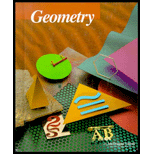
Concept explainers
To find:The ratios of base circumferences, slant heights, lateral areas, total areas and volumes of two similar cones.
Answer to Problem 7CE
The two similar cones has base circumferences ratio is
Explanation of Solution
Given information:
The scale factor of two similar cones is
Calculation:
The ratio of the corresponding sides of any two similar geometric figures is termed as Scale factor.The theorem of similar
(i) The ratio of base areas, lateral areas and total areas is
(ii) The ratio of base circumferences is
(iii) The ratio of their volumes is
Let the two slant heights of cones be
Expression to find the base circumferences from the above theorem is:
Substitute
Therefore, the ratio of base circumferences of two similar cones is
Expression to find the slant height from the above theorem is:
Substitute
Therefore, the ratio of slant height of two similar cones is
Expression to determine the lateral area of two similar cones from the similar solids theorem is:
Substitute
Therefore, the ratios of lateral areas of two similar conesis
Expression to determine the total area of two similar cones from the above theorem is:
Substitute
Therefore, the ratios of total areas of two similar conesis
Expression to determine the volumes of two similar cones from the above theorem is:
Substitute
So, the ratios of volumes of two similar conesis
Therefore,the two similar cones base circumferences ratio is
Chapter 12 Solutions
McDougal Littell Jurgensen Geometry: Student Edition Geometry
Additional Math Textbook Solutions
Elementary Statistics: Picturing the World (7th Edition)
Algebra and Trigonometry (6th Edition)
Thinking Mathematically (6th Edition)
Elementary Statistics
Introductory Statistics
A Problem Solving Approach To Mathematics For Elementary School Teachers (13th Edition)
- 00 5 N -10 ·2· 3∙ 4 5 9 -co- 10arrow_forward10- -10 -5 6 0 10 -10- -15 10arrow_forwardix.com/math/grade-6/area-of-compound-figures-with-triangles Play Prodigy E May include: A blue... Play Prodigy Settings - About Chr... Analytics G one one-G What is the area of this figure? 3 yd 4 yd 6 yd 9 yd 9 yd 18 yd Write your answer using decimals, if necessary. square yards Submit esc -> C Desk 1 5 yd Work it out Not feeling ready yet? These can helparrow_forward
- Home-Student Portalarrow_forwardWhat is the area of this figure? 3 mi 5 mi 6 mi 4 mi 2 mi 3 mi 6 mi Write your answer using decimals, if necessary. 5 miarrow_forwardAnswer all questions and show workarrow_forwardSolve for angle QTUarrow_forwardThe diagram below models the layout at a carnival where G, R, P, C, B, and E are various locations on the grounds. GRPC is a parallelogram. Part A: Identify a pair of similar triangles. Part B: Explain how you know the triangles from Part A are similar. Part C: Find the distance from B to E and from P to E. Show your work. Make sure to explain and show your work for each part.arrow_forwardThe diagram below models the layout at a carnival where G, R, P, C, B, and E are various locations on the grounds. GRPC is a parallelogram. Part A: Identify a pair of similar triangles. Part B: Explain how you know the triangles from Part A are similar. Part C: Find the distance from B to E and from P to E. Show your work.arrow_forwardAREA OF COMPOUND FIGURE A compound shape is made up of basic shapes put together. To find the area of a compound shape, follow these steps: 1. Break the compound shape into basic shapes. 2. Find the area of each basic shape. 3. Add the areas. Example: Area A 2 x 9 = 18 Area B = 4x4 = 16 2 ft. Total area = 18+ 16 = 34 9 ft. A 5 ft. 6 ft. 4 ft. B 4 ft.arrow_forwardi know that angle ZPY is 55 and arc zy is 110. How is arc wx 125arrow_forwardi know that angle ZPY is 55 and arc ZY is 110. How is arc WX 125?arrow_forwardarrow_back_iosSEE MORE QUESTIONSarrow_forward_ios
 Elementary Geometry For College Students, 7eGeometryISBN:9781337614085Author:Alexander, Daniel C.; Koeberlein, Geralyn M.Publisher:Cengage,
Elementary Geometry For College Students, 7eGeometryISBN:9781337614085Author:Alexander, Daniel C.; Koeberlein, Geralyn M.Publisher:Cengage, Elementary Geometry for College StudentsGeometryISBN:9781285195698Author:Daniel C. Alexander, Geralyn M. KoeberleinPublisher:Cengage Learning
Elementary Geometry for College StudentsGeometryISBN:9781285195698Author:Daniel C. Alexander, Geralyn M. KoeberleinPublisher:Cengage Learning

